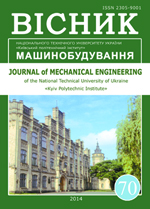EVALUATION OF STRENGTH AND FRACTURE RISK OF PIPELINE UNDER ACTION OF HYDROGEN-CONTAINED ENVIRONMENTS
DOI:
https://doi.org/10.20535/2305-9001.2014.70.33629Keywords:
low alloyed pipeline steel, hydrogen-contained environments, hydrogen charging of metal, hydrogen concentration, stress concentratorsAbstract
The work is dedicated to the evaluation of strength and risk of fracture of pipeline under action of gaseous hydrogen or potentially hydrogen-contained environments.
Purpose. Determining of the hydrogen effect on local strength and fracture risk of pipe with stress concentrators.
Design/methodology/approach. The low-alloyed steel X52 with the dominant pearlite-ferrite structure, which is the most usable in the existed gas pipelines, was studied by the combination of methods of mechanics of materials, physical chemistry and materials science.
Findings. The dependencies of the work for local fracture initiation from stress concentrator as well as the total work for notched specimen fracture were determined as the function of the hydrogen concentration in the bulk of metal.
Originality/value. The existence of some critical hydrogen concentration , at which the essential decreasing of steel fracture resistance occurs, has been shown. This value can be considered as an important engineering parameter for strength and fracture assessment of materials and structural components in hydrogenous environments.References
Dey S. Study on hydrogen absorption of pipeline steel under cathodic charging / S. Dey, A.K. Mandhyan, S.K. Sondhi [and all] // Corrosion Science. – 2006. – Vol. 48. –P. 2676–2688.
Hardie D. Effect of hydrogen and strain rate upon the ductility of mill-annealed Ti5Al3V / D. Hardie, S. Ouyang // Corrosion Science. – 1999. – Vol. 41, № 1. – P. 155–177.
Ibeh B. Separation of hydrogen from a hydrogen/methane mixture using a PEM fuel cell / Blessing Ibeh, Chris Gardner, Marten Ternan // International Journal of Hydrogen Energy. – 2007. – V. 32, Is. 7. – P. 908–914.
Katz Y. Nanomechanical probes as new approaches to hydrogen/deformation interaction studies / Y. Katz, N. Tymiak, W.W. Gerberich // Engineering Fracture Mechanics. – 2001. – Vol. 68. – P. 619–646.
Murakami Y. The effect of hydrogen on fatigue properties of steels used for fuel cell system / Y. Murakami, H. Matsunaga // International Journal of Fatigue. – 2006, Vol. 28. – P. 1509–1520.
Hanneken J.W. Hydrogen in metals and other materials: a comprehensive reference to books, bibliographies, workshops and conferences / John W. Hanneken // International Journal of Hydrogen Energy. – 1999. – V. 24, Is. 10. – P. 1005–1026.
Hydrogen Energy Systems: Production and Utilization of Hydrogen and Future Aspects: [Proceedings of the NATO Advanced Study Institute / Ed. Yuda Yürüm]. – London (UK): Kluwer Academic Publisher, 1995. – 341 p. – (NATO Science Series E: Applied Science – Vol. 295).
Capelle J. Using the Existing Natural Gas Network to Transport Hydrogen / J. Capelle, I. Dmytrakh, J. Gilgert G. Pluvinage // Le climat en question: séminaire EMMA, 10 May 2007: proceedings. – Nancy (France): University of Nancy, 2007. – P. 14.
Azevedo C.R.F. Failure analysis of a crude oil pipeline / Cesar R.F. Azevedo // Engineering Failure Analysis. – 2007. – V. 14, Is. 6. – P. 978–994.
Cheng Y.F. Fundamentals of hydrogen evolution reaction and its implications on near-neutral pH stress corrosion cracking of pipelines / Y.F. Cheng // Electrochimica Acta. – 2007. – V. 52, Is. 7. – P. 2661–2667.
Cheng Y.F. Mechanism for hydrogen evolution reaction on pipeline steel in near-neutral pH solution / Y.F. Cheng, L. Niu // Electrochemistry Communications. – 2007. – V. 9, Is. 4. – P. 558–562.
Dey S. Hydrogen entry into pipeline steel under freely corroding conditions in two corroding media / S. Dey, A.K. Mandhyan, S.K. Sondhi, I. Chattoraj // Corrosion Science. – 2006. – V. 48, Is. 9. – P. 2676–2688.
Shipilov S.A. Structural integrity of aging buried pipelines having cathodic protection / Sergei A. Shipilov, Iain Le May // Engineering Failure Analysis. – 2006. – V. 13, Is. 7. – P. 1159–1176.
Capelle J. Sensitivity of pipelines with steel API X52 to hydrogen embrittlement / J. Capelle, J. Gilgert, I. Dmytrakh, G. Pluvinage // International Journal of Hydrogen Energy. – 2008. – V. 33, Is. 24. – P. 7630–7641.
Capelle J. The effect of hydrogen concentration on fracture of pipeline steels in presence of a notch / J. Capelle, J. Gilgert, I. Dmytrakh, G. Pluvinage // Engineering Fracture Mechanics. – 2011. – V. 78, Is. 2. – P. 364–373.

